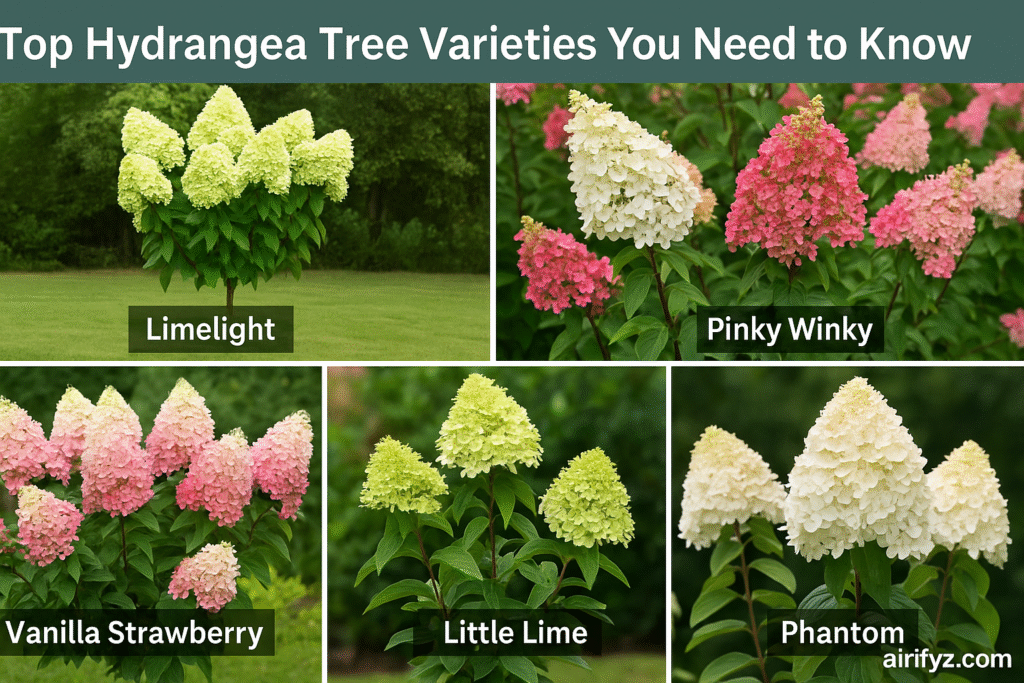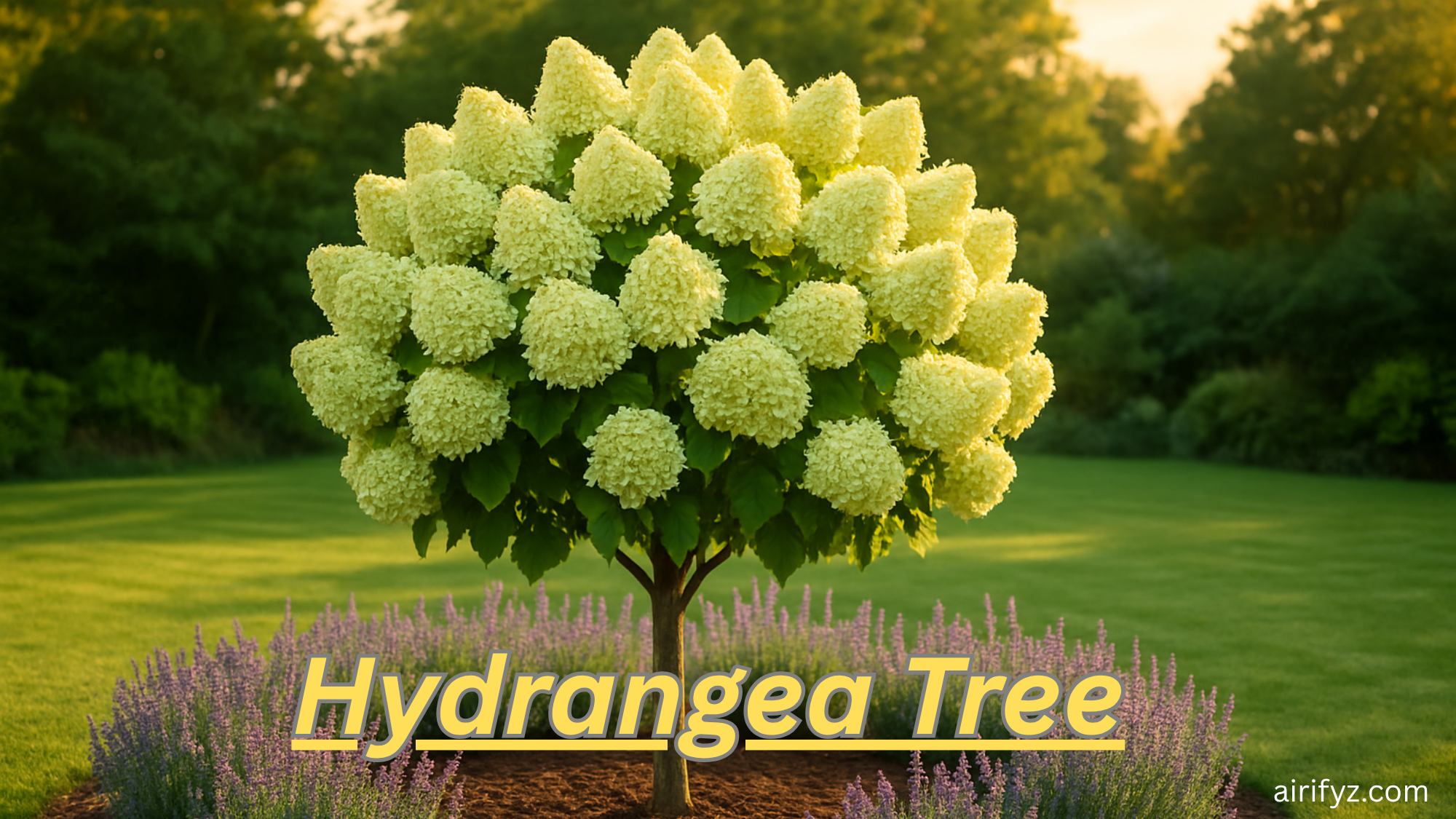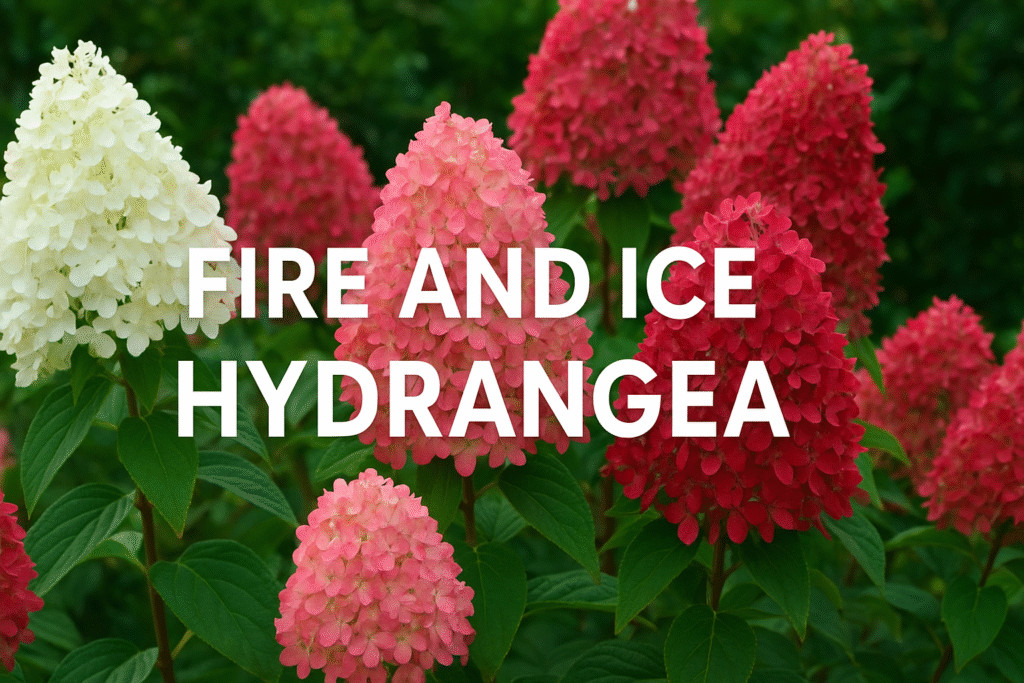INTRODUCTION:
For years, I believed hydrangeas were just those puffy, flowering shrubs that added color to cottage gardens. That was until I visited a small town garden tour in New England—and saw my first hydrangea tree. Standing tall like a graceful queen among the flowerbeds, it had the same lush blooms I loved, but elevated—literally.
Today, we’re diving deep into the secrets behind these dramatic garden centerpieces: how to care for them, how to design around them, and most importantly, how to make your own thrive.
🌿 What Exactly Is a Hydrangea Tree?
Let’s start with a little-known fact: a hydrangea tree isn’t a separate species. It’s actually a panicle hydrangea (Hydrangea paniculata) that has been trained and pruned to grow as a small tree, typically around 6 to 8 feet tall. Think of it as a well-groomed version of a classic shrub—with a single trunk and a rounded canopy of blooms.
“Hydrangea trees combine the structure of an ornamental tree with the showy flowers of a shrub—making them a stunning dual-purpose feature,” says Carla Mason, horticulturist and author of Garden Color Theory.
🌼 Why Choose a Hydrangea Tree?
Hydrangea trees are rising in popularity for several reasons:
- Year-round interest: Gorgeous blooms in summer, striking dried flowers in winter.
- Small-space friendly: Ideal for courtyards, patios, or even containers.
- Easy care: More forgiving than you’d think.
- Design versatility: Looks equally beautiful in cottage, formal, or contemporary gardens.

🌸 Top Hydrangea Tree Varieties You Need to Know
Let’s break down the best-performing varieties for your landscape:
1. Limelight Hydrangea Tree
- Bloom: Lime green fading to ivory and blush pink
- Height: Up to 8 feet
- Perk: Sun-tolerant and heat-resistant
2. Pinky Winky
- Bloom: White cones that turn deep pink from the base up
- Why it stands out: Striking bi-color effect as blooms mature
3. Vanilla Strawberry
- Bloom: Starts off creamy white, then turns pink, and finally becomes a deep strawberry red.
- Special Trait: Ever-changing color palette through the season
4. Little Lime
- Bloom: Compact form of Limelight, perfect for containers
- Bonus: Just 3 to 5 feet tall—great for small gardens
5. Phantom
- Bloom: Massive white flower heads that turn soft pink
- Ideal for: Backyard focal points or hedging
✂️ How to Care for a Hydrangea Tree (That Nobody Tells You)
Hydrangea trees are low-maintenance, but a few expert tricks can make a huge difference in performance.
💧 Watering Secrets
Hydrangea trees love consistent moisture, especially in the first 1–2 years.
- Water 2–3 times per week in dry weather
- Use 2–3 inches of mulch to lock in moisture and keep roots cool
Pro Tip: Avoid overwatering—roots can rot in poorly draining soil.
🌤️ Sunlight & Location
- Best Placement: Morning sun + afternoon shade
- Can tolerate full sun, especially the Limelight variety
🌱 Soil & Feeding
- Prefers rich, well-drained soil
- Enrich with organic compost in early spring
- Apply a balanced fertilizer (10-10-10) in late spring for bigger blooms
✂️ The Right Way to Prune a Hydrangea Tree
“The #1 mistake people make? Pruning too late in spring,” says expert grower Linda Feldman.
Hydrangea trees bloom on new wood, which means:
- Trim the plant in late winter or early spring, before it starts growing new leaves or flowers.
- Remove old or crossing branches
- Shape the top into a neat canopy, avoiding cuts to the central leader trunk
🎨 Bloom Color Secrets—Do They Really Change?
Here’s the shocker: not all hydrangea trees can change color.
Only bigleaf hydrangeas (Hydrangea macrophylla) can change color from pink to blue depending on the soil’s pH level.
Most tree varieties like Limelight or Pinky Winky naturally bloom white or green and slowly blush pink as they age.
Soil pH Tip: For blue blooms, lower pH with aluminum sulfate. For pink, raise it with garden lime—but only if you’re growing a macrophylla, not a tree.
🌳 How to Design with Hydrangea Trees Like a Pro
Hydrangea trees offer architectural interest and soft color. Here are some smart ideas:
🏡 Front Yard Focal Point
Anchor your walkway or entry with a symmetrical pair
🌾 Cottage Garden Centerpiece
Plant one as a central feature surrounded by lavender or salvia
🪴 Container Garden Charm
Grow a compact variety like Little Lime in a large terra cotta pot
🌲 Backyard Border
Mix with evergreens or ornamental grasses for four-season contrast
📅 Your Seasonal Hydrangea Tree Care Calendar
| Season | Tasks |
|---|---|
| Spring | Prune, feed, apply compost, inspect for pests |
| Summer | Water regularly, deadhead blooms, mulch base |
| Fall | Cut back spent blooms, reduce watering |
| Winter | Mulch base, avoid pruning, protect from frost |
You can also read about: Hydrangeas 101: Expert Tips on Varieties, Care, Color & Design
🧠 A Thoughtful Look: Why Hydrangea Trees Deserve More Credit
Despite their beauty, hydrangea trees are often misunderstood. They’re labeled as “tricky” or “high-maintenance,” but in reality, they’re some of the easiest flowering trees you can grow—with a little know-how.
They’re a perfect mix between a flowering shrub and a decorative tree. They adapt to climate extremes, support pollinators, and lend a touch of old-world charm to any garden. With some simple seasonal care and smart placement, your hydrangea tree will give you years of rewarding beauty.
“People think trees need decades to impress. A hydrangea tree proves them wrong in one season.” —Ava Richards, Landscape Architect
🌟 Final Thoughts: Bring Structure, Elegance, and Color to Your Garden
The secret’s out—hydrangea trees aren’t just for professional landscapers or estate gardens. They’re for every gardener who wants impact without intimidation.
So whether you’re designing from scratch or upgrading your flower bed, let a hydrangea tree steal the spotlight. It’s one of those garden upgrades that pays off season after season.
Ready to elevate your garden with the magic of a hydrangea tree?
🌱 Start planning your planting spot today—and watch your space transform.🔍 FAQs About Hydrangea Trees
1. Can I turn a regular hydrangea into a tree?
👉 Only Hydrangea paniculata can be trained into tree form, not bigleaf or oakleaf types.
2. Do hydrangea trees need full sun?
👉 Most thrive in partial sun but can handle full sun if watered well.
3. How tall do hydrangea trees get?
👉 Typically 6 to 8 feet, though some compact types stay under 5.
4. Do I need to stake my hydrangea tree?
👉 Newly planted trees benefit from staking during the first year to stay upright.
5. Are hydrangea trees good for small gardens?
👉 Absolutely. Try Little Lime or Bobo varieties for tighter spaces.



